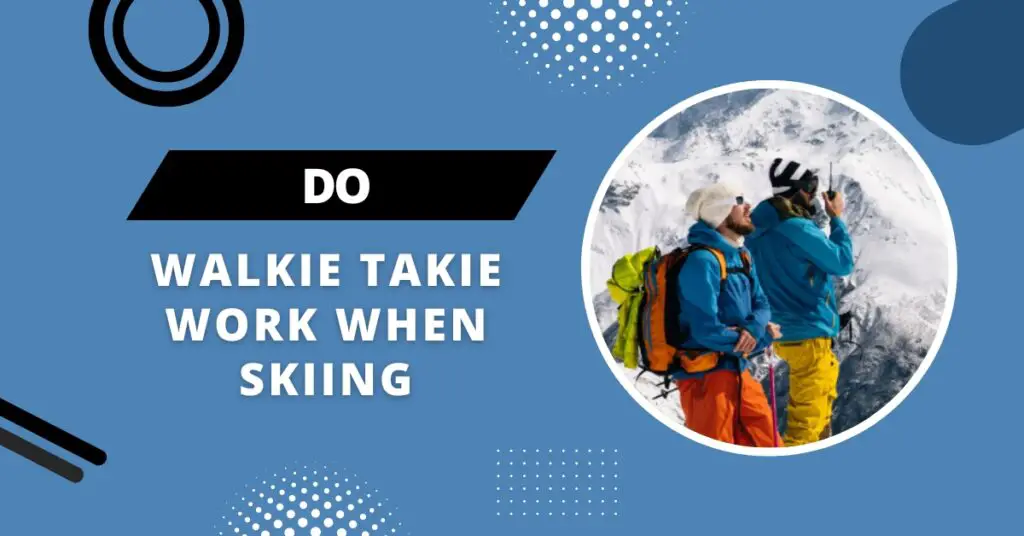Last updated on June 15th, 2023 at 11:25 am
Find out Do walkie takie work when skiing? by learning about their range, frequency, and potential interference. Discover tips for maximizing the effectiveness of your walkie-talkies on the slopes.
Introduction:
You are staying in touch with friends and family while skiing can be a crucial part of your skiing experience. One way to accomplish this is by using walkie-talkies, but you may wonder if these will work effectively when you’re skiing.
We will examine the factors that can affect the performance of walkie talkies for skiing and offer tips on how to make the most of them.
What is Skiing?
In skiing, long, narrow pieces of equipment made of wood, metal, or plastic are used to slide down slopes while skiers navigate groomed trails, backcountry terrain, and jumps in parks.

Skiing can be divided into several types, including alpine skiing, cross-country skiing, freestyle skiing, and telemark skiing.
1. Alpine skiing
Skiing down a mountain on groomed slopes or in the backcountry is also known as downhill skiing.
2. Cross-country
Cross-country, skiing is done on groomed trails or in the backcountry, on flat or gently rolling terrain.
3. Freestyle skiing

Some many tricks and stunts are performed on skis, including halfpipes, slopestyle, and moguls.
4. Telemark skiing
In telemark skiing, the skier lifts the heel of their ski off the ground using a specific type of ski binding.
5. Final words
People of all ages and skill levels can enjoy skiing, whether they are beginners or seasoned professionals. Skiing is a great way to get exercise and enjoy the outdoors, as well as an exhilarating sport. It’s a rewarding and fun sport for everyone, whether you’re a seasoned pro or just starting.
Do Walkie Takie Work When Skiing?

It is a portable communication device that uses radio waves to transmit and receive messages over short distances, also known as a two-way radio. While skiing, they can be an effective tool for staying in touch with friends and family, but it is important to determine if they will function effectively in the mountainous terrain.
1. Range
A walkie-talkie’s range can affect its performance while skiing. Most walkie-talkies have a maximum range of approximately 2 miles, but this range can be affected by factors such as terrain, obstacles, and weather.
As a result of the terrain and the presence of obstacles, your walkie-talkies may have a limited range in the mountains.
2. Frequency
Another factor to consider is the frequency of the walkie-talkies. Different walkie-talkies operate on different frequencies, and some frequencies may be more prone to interference in certain environments.
For example, walkie-talkies that operate on the UHF frequency band may be more prone to interference in mountainous terrain due to the presence of rocks and other natural obstacles.
3. Cold Weather
Choosing a walkie-talkie with a wide range and a frequency that is less likely to interfere with your skiing will maximize the effectiveness of your walkie-talkie. In addition, you should select a device that is appropriate for the conditions in which you will be skiing.
For example, if you will be skiing in extreme cold or wet conditions, you may wish to choose a walkie-talkie that is waterproof and rated for cold temperatures.
4. Final Words
A variety of factors, including range, frequency, and environmental conditions, may affect the performance of walkie-talkies when skiing. To maximize the effectiveness of your walkie-talkies on the slopes, choose a device that has a good range and a suitable frequency, as well as consider the conditions you will be skiing in.
Top 11 tips on how to make your skiing trip more fun

You can use walkie-talkies on your ski trip to keep in touch with family and friends. Here are 11 tips to make your ski trip more enjoyable.
1. Choose the right walkie-talkie:
Consider your skiing conditions and choose a device that is suitable for those conditions. Choose a walkie-talkie with a good range and a frequency that is less susceptible to interference.
2. Stay in touch:
Keep in touch with your family and friends while on the mountain by using walkie-talkies. They can be used to coordinate meet-ups, share updated location information, or just chat.
3. Plan ahead:
You should always make sure that you have enough batteries or a charged power bank so that your walkie-talkies will remain charged throughout the day.
4. Stay safe:
If you become separated from your group or if someone becomes injured, use your walkie-talkies to communicate with each other.
5. Take breaks:

If necessary, use your walkie-talkie to coordinate breaks with your group. Take breaks for rest, hydration, and refueling with food and water.
6. Explore different trails:
Communicate with your group while exploring different parts of the mountain with your walkie-talkies. In this way, you will avoid getting lost and will be able to stay together.
7. Get some rest:
If you are taking breaks or resting at night, make sure you keep in touch with your group using your walkie-talkies.
8. Try something new:
During your winter sports activities, such as snowboarding, ice skating, or snowshoeing, make use of your walkie-talkies to communicate with your group.
9. Play games:
Take advantage of your walkie-talkies by playing games with your friends, such as Marco Polo or I Spy.”
10. Share updates:

If you own a walkie-talkie, you should use it to communicate with your group about your location, the weather, or any other relevant information.
11. Have fun:
Don’t forget to have fun on your ski trip with your friends and family and to enjoy yourself.
Final Words
With the help of your walkie-talkies, you can make your winter ski trip more enjoyable and enjoyable by following these tips.
FAQ’s
1: How to avoid dehydration on your ski trip?
During skiing and snowboarding, you must drink adequate amounts of water before, during, and after your time on the slopes. The general recommendation is to drink 67 ounces of water a day. For an individual recommendation, take 67% of your body weight and multiply it by 12.
2: How can I improve the performance of my walkie-talkies while skiing?
The following tips will help you improve the performance of your walkie-talkies while skiing:
1: You should choose a walkie-talkie with a long range and a frequency that is less likely to interfere with each other
2: Keep your walkie-talkies powered up throughout the day by bringing plenty of batteries or a charged power bank
3: Ensure that you are in an open area with a clear line of sight to other users to maximize your range
4: It is recommended not to use your walkie-talkie near large metal objects or structures, as they can interfere with the signal.
5: It is recommended that you do not use your walkie-talkie near other electronic devices as they may interfere with the signal
Can walkie-talkies work in extreme cold or wet conditions?
In some cases, walkie-talkies are waterproof and designed for cold temperatures, so they can function even in extremely cold or wet conditions.
It is important to check the specifications of your particular walkie-talkie to be sure that it is suitable for use in such conditions. In general, it is a good idea to keep your walkie-talkie as dry as possible to keep it from getting damaged by moisture.
Do walkie-talkies have a range limit?
There is typically a maximum range of 2 miles for most walkie-talkies, but this range can vary depending on several factors, including the terrain, the presence of obstacles, and the weather. Your walkie-talkies can be limited in range in the mountains due to the terrain and the presence of obstacles such as trees and buildings.
If you want your walkie-talkies to have the best range, you should try to use them in an open area where there is a clear line of sight to other users, and you should avoid using them near large metallic objects or structures, as these can block the signal.
Conclusion
However, range, frequency, and environmental conditions can affect the performance of walkie-talkies while skiing. It is important to choose a walkie-talkie with a good range and a frequency that is less likely to interfere, as well as to consider the conditions you will be skiing in when choosing your walkie-talkies. Thank you for taking the time to read this blog. I hope you find it useful.
